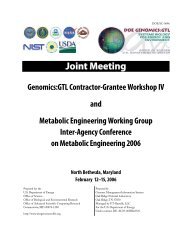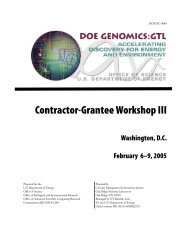Joint Meeting - Genomics - U.S. Department of Energy
Joint Meeting - Genomics - U.S. Department of Energy
Joint Meeting - Genomics - U.S. Department of Energy
You also want an ePaper? Increase the reach of your titles
YUMPU automatically turns print PDFs into web optimized ePapers that Google loves.
6<br />
Systems Biology for DOE <strong>Energy</strong> and Environmental Missions<br />
This poster illustrates our approach to understanding<br />
Biomass formation transformation using Populus,<br />
which along with switchgrass are our primary feedstock<br />
targets. The goal <strong>of</strong> this area is to develop a thorough<br />
understanding <strong>of</strong> the genetics and biochemistry <strong>of</strong> plant<br />
cell wall biosynthesis so the process can be modified to<br />
reduce biomass recalcitrance. Preliminary data supporting<br />
our hypothesis that modification <strong>of</strong> cell wall structure<br />
will result in lower recalcitrance <strong>of</strong> biomass have been<br />
shown in alfalfa.<br />
The Populus genome was sequenced, assembled and<br />
annotated in 2006. As a result, there have been numerous<br />
genetic and genomics tools developed for the discovery <strong>of</strong><br />
genes and gene function in Populus. These tools include<br />
saturated genetic maps, whole-genome microarrays,<br />
libraries <strong>of</strong> polymorphic features within the genome, and<br />
a catalog <strong>of</strong> 45,500 predicted gene models. Moreover,<br />
there are in place extensive structured pedigrees, routine,<br />
high-throughput transformation protocols and mutated<br />
genetic lines available for study. These tools and resources<br />
will be brought to bear on the issue <strong>of</strong> the recalcitrance <strong>of</strong><br />
plant cell walls to microbial and enzymatic deconstruction<br />
and conversion into liquid transportation fuels.<br />
Although such resources exist, we know very little about<br />
the regulation, formation and synthesis <strong>of</strong> plant cell walls.<br />
As such, the first efforts within the Populus Transformation<br />
activity will be to identify all genes related to the<br />
construction <strong>of</strong> primary and secondary plant cell walls.<br />
It is estimated that as many as 5000 genes may be active<br />
during the process <strong>of</strong> cell wall formation. Genetics and<br />
genomics approaches will be used to identify 1000 genes<br />
with the largest impact on cell wall chemistry and thermochemical<br />
conversion to sugars. These 1000 genes and<br />
their effect on cell wall biosynthesis, recalcitrance and<br />
sugar release will then be tested and validated in over-<br />
and under-expression transgenic lines. An annotated<br />
and curated plant wall biosynthesis gene database will<br />
be created and the database will be used to construct cell<br />
wall biosynthesis pathways to facilitate future approaches<br />
to reduce recalcitrance <strong>of</strong> plant biomass.<br />
The goal <strong>of</strong> the BESC Populus Transformation effort<br />
is to create improved plant lines that express enhanced<br />
biomass production and reduced recalcitrance, i.e. plants<br />
that are more easily deconstructed for bi<strong>of</strong>uel production.<br />
Our specific goals are to: 1) identify and characterize<br />
genes involved in cell wall biosynthesis and structure<br />
and to establish which genes alter biomass recalcitrance<br />
and 2) determine how changes in cell wall composition<br />
and structure affect plant recalcitrance and to begin to<br />
develop a systems biology understanding <strong>of</strong> the genetic<br />
* Presenting author<br />
basis for wall structure and recalcitrance. A detailed<br />
experimental approach will be presented.<br />
5<br />
BESC: Biomass Deconstruction<br />
and Conversion: A Systems Biology<br />
Analysis <strong>of</strong> Biomass Ethanol from<br />
Clostridium thermocellum<br />
GTL<br />
Babu Raman, 1 Jonathan R. Mielenz, 1 Catherine K.<br />
McKeown, 1 Miguel Rodriguez Jr., 1 Steven D. Brown, 1<br />
Patricia K. Lankford, 1 Chongle Pan, 1 Gregory B. Hurst, 1<br />
L. Lynd, 2 and M. Keller 1 * (kellerm@ornl.gov)<br />
1Oak Ridge National Laboratory, Oak Ridge,<br />
Tennessee and 2Dartmouth College, Hanover, New<br />
Hampshire<br />
Project Goals: The overriding goal <strong>of</strong> the Center is to<br />
engineer wall biosynthesis pathways to generate plants<br />
with less recalcitrant walls that are deconstructed<br />
effectively by consolidated microbial bioprocessing,<br />
ultimately achieving optimal sugar release and conversion<br />
from the biomass with minimal or no chemical<br />
pretreatment. These efforts will be supported by<br />
the development <strong>of</strong> chemical and molecular models<br />
that predict how wall structure, recalcitrance, and<br />
biocatalyst-biomass interactions are related and by<br />
experimental and theoretical approaches to refine these<br />
models.<br />
This poster illustrates part <strong>of</strong> our approach in Biomass<br />
deconstruction and Conversion using an example <strong>of</strong><br />
the analysis <strong>of</strong> Clostridia thermocellum. The conversion<br />
goal is to develop an understanding <strong>of</strong> enzymatic and<br />
microbial biomass deconstruction, characterize and mine<br />
biodiversity, and use this knowledge to develop superior<br />
biocatalysts for consolidated bioprocessing (CBP). Four<br />
biologically mediated events occur in fuel production<br />
from biomass featuring enzymatic hydrolysis—saccharolytic<br />
enzyme production, hydrolysis, fermentation<br />
<strong>of</strong> six-carbon sugars, and fermentation <strong>of</strong> five-carbon<br />
sugars. Although these events are accomplished in<br />
several process steps in near-term designs, they could in<br />
principle be combined into a single step mediated by one<br />
microbe or microbial community. Recent data suggest<br />
a microbe-enzyme-substrate synergy results from this<br />
consolidation. A CBP approach has been described as the<br />
“ultimate low-cost configuration for cellulose hydrolysis<br />
and fermentation.” Development <strong>of</strong> CBP will result in<br />
the largest projected cost reduction <strong>of</strong> all R&D-driven<br />
improvements. One <strong>of</strong> the leading candidate microorgan-





